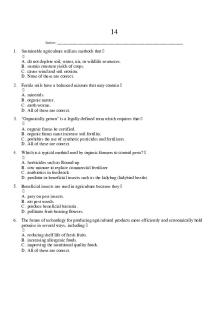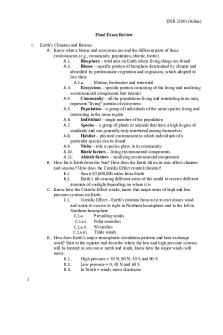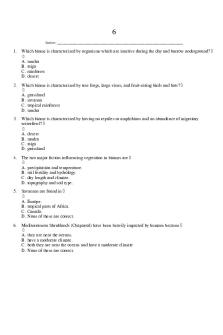BIO LAB Intro to Science PDF

| Title | BIO LAB Intro to Science |
|---|---|
| Course | Biological Science Lab |
| Institution | Arkansas State University |
| Pages | 12 |
| File Size | 294.8 KB |
| File Type | |
| Total Downloads | 20 |
| Total Views | 158 |
Summary
Biological Science Lab Assignment Introduction to Science....
Description
Introduction to Science EXERCISE 1: DATA INTERPRETATION Dissolved oxygen is oxygen that is trapped in a fluid. Since many living organisms require oxygen to survive, it is a necessary component of water systems (streams, lakes, rivers, etc.). Dissolved oxygen is measured in units of parts per million (ppm). Examine the data in Table 4, which shows the amount of dissolved oxygen present in a body of water and the number of fish observed in the sample. Then, answer the questions below.
Table 4: Water Quality vs. Fish Population Dissolved Oxygen (ppm)
0
2
4
Number of Fish Observed
0
1
3
6
8
10
12 14 16 18
10 12 13
15 10 12 13
1. What patterns do you observe based on the information in Table 4?
The table shows that dissolved oxygen (ppm) constantly increases by a rate of 2. The number of fish observed also increases with an irregular pattern. The number of fish suddenly decreases when the dissolved oxygen is at the level of 14 ppm and continues to increase after that.
2. Develop a hypothesis relating to the amount of dissolved oxygen measured in the water sample and the number of fish observed in the body of water.
The more dissolved oxygen is in the body of water, the more number of fish observed.
3. What would your experimental approach be to test this hypothesis?
My experimental approach would be using different bodies of water with different ppm level. Then I would observe how many fishes are there in each water body.
4. What would be the independent and dependent variables?
The independent variable is ppm level in water. The dependent variable is amount of fish.
©eScience Labs, 2018
Introduction to Science 5. What would be your control?
My control would be same fish tanks, same location, and same temperature.
©eScience Labs, 2018
Introduction to Science EXERCISE 2: TESTABLE OBSERVATIONS Determine which of the observations below are testable. For those that are testable:
Determine if the observation is qualitative or quantitative. Write a hypothesis and a null hypothesis. What would be your experimental approach? What are the dependent and independent variables? What are your controls - both positive and negative? How will you collect your data? How will you present your data (e.g., charts, graphs, types)? How will you analyze your data?
Observations 1. A plant grows 3 cm faster per day when placed on a windowsill than it does when placed on a coffee table in the middle of the living room.
This observation is testable. This observation is quantitative. My hypothesis is: the plant that placed on a windowsill will grow 3 cm faster than the plant that placed on a coffee table in the middle of the living room. The null hypothesis is the plant that is placed on a windowsill will grow at the same rate as a plant that is placed on a coffee table in the middle of the living room. My approach is that I would measure the length of the plant first. Then I would put one on a windowsill and one on a coffee table in the middle of the living room. In the next 24 hours, I would measure these two plants again to see if there is any change. The independent variable is the location of a plant, and the dependent variable is the growth of the plant. The positive control is the growth of the plant that is placed on the windowsill. The negative control is the growth of the plant that is placed on the coffee table in the middle of the living room. I would collect data by measuring the plants every 24 hours for 3 days and compare the difference. I would use a line graph to present my data. In the analyzing steps, if the hypothesis is supported, I will consider additional variables that should be examined. If the data does not provide clear result, I will run additional trials or revising the procedure to create more precise outcome.
6. The bank teller with brown hair and brown eyes is taller than the other tellers.
This observation is not testable.
©eScience Labs, 2018
Introduction to Science 7. When Sally eats healthy foods and exercises regularly, her blood pressure is 10 points lower than when she eats fatty foods and does not exercise.
This observation is testable. This is a quantitative observation. My hypothesis is that Sally’s blood pressure will be 10 points lower if she eats healthy foods and exercises regularly than when she eats fatty foods and does not exercise. My null hypothesis is that if Sally eats healthy foods and exercises, her blood pressure will stay the same as when she eats fatty foods and does not exercises. My approach is that I would have her to exercise and eat healthy for 5 days and calculating the blood pressure every day. Then Sally would eat fatty foods and wouldn’t exercise for the next 5 days and calculating the blood pressure every day. After that, I will compare the difference. The independent variable is kinds of food and exercise. Dependent variable is Sally’s blood pressure level. Positive control is healthy diet and exercise, and negative control is fatty diet and not exercise. I will collect by recording the blood pressure level of Sally when she eats healthy and exercises for 5 days and when she does not exercise and eats fatty foods for the next 5 days. The line graph will be used to present my data. In the analyzing steps, if the hypothesis is supported, I will consider additional variables that should be examined. If the data does not provide clear result, I will run additional trials or revising the procedure to create more precise outcome.
8. The Italian restaurant across the street closes at 9 pm, but the restaurant two blocks away closes at 10 pm.
This observation is not testable.
9. For the past two days, the clouds have come out at 3 pm, and it has started raining at 3:15 pm.
This observation is not testable.
10. George did not sleep at all the night following the start of Daylight Savings Time.
This observation is not testable.
©eScience Labs, 2018
Introduction to Science EXERCISE 3: CONVERSION Use Figure 9 to convert each value into the designated units.
Figure 9: Conversions for temperature, time, mass, and length.
1. 46,756,790 mg = 46.76 kg 2. 5.6 hours = 336 seconds 3. 13.5 cm = 5.31 inches 4. 47 °F = 8.33 °C
©eScience Labs, 2018
Introduction to Science EXERCISE 4: ACCURACY AND PRECISION Determine whether the following statements are accurate, precise, both, or neither. Circle your answer.
1. During gym class, four students decided to see if they could perform the norm of 45 situps in one minute. The first student did 64 sit-ups, the second did 69, the third did 65, and the fourth did 67.
Accurate
Precise
Both
Neither
11. The average score for the 5th-grade math test is 89.5. The top 5th graders took the test and scored 89, 93, 91, and 87.
Accurate
Precise
Both
Neither
12. Yesterday the temperature was 89 °F, tomorrow it’s supposed to be 88 °F, and the next day it’s supposed to be 90 °F, even though the average temperature for September is 75 °F.
Accurate
Precise
Both
Neither
©eScience Labs, 2018
Introduction to Science 13. Four friends decided to play horseshoes. They took a picture of their results:
Accurate
Precise
Both
Neither
14. A local grocery store held a contest to see who could most closely guess the number of pennies inside a large jar. The first six people guessed the numbers 735, 209, 390, 300, 1005, and 689. The grocery clerk said the jar actually contains 568 pennies.
Accurate
Precise
Both
Neither
©eScience Labs, 2018
Introduction to Science EXERCISE 5: SIGNIFICANT DIGITS AND SCIENTIFIC NOTATION Part 1 mn Determine the number of significant digits in each number and write the specific significant digits.
1. 405000 has 3 significant digits: 4,0,5 2. 0.0098 has 2 significant digits: 9,8 3. 39.999999 has 8 significant digits: 3,9,9,9,9,9,9,9 4. 13.00 has 4 significant digits: 1,3,0,0 5. 80,000,089 has 8 significant digits: 8,0,0,0,0,0,8,9 6. 55,430.00 has 7 significant digits: 5,5,4,3,0,0,0 7. 0.000033 has 2 significant digits: 3,3 8. 620.03080 has 8 significant digits: 6,2,0,0,3,0,8,0
Part 2 Convert each number into scientific notation.
1. 70,000,000,000 = 7 x 1010
15. 0.000000048 = 4.8 x 10-8
16. 67,890,000 = 6.789 x 107
17. 70,500 = 7.05 x 104
18. 450,900,800 = 4.509008 x 108
19. 0.009045 = 9.045 x 10-3
©eScience Labs, 2018
Introduction to Science 20. 0.023 = 2.3 x 10-2
©eScience Labs, 2018
Introduction to Science EXERCISE 6: PERCENTAGE ERROR Determine the percentage error in each scenario. Show your work on all problems.
1. A dad holds five coins in his hand. He tells his son that if he can guess the amount of money he is holding within 5% error, he can have the money. The son guesses that dad is holding 81 cents. The dad opens his hand and displays 90 cents. Did the son guess close enough to get the money?
The son did not guess close enough to get the money. Because the percentage error is: |81-90| / 90 x 100 = 10% error. Therefore, the percentage error is greater than 5% error.
21. A science teacher tells her class that their final project requires students to measure a specific variable and determine the velocity of a car with no more than 2.5% error. Jennifer and Johnny work hard and decide the velocity of the car is 34.87 m/s. The teacher informs them that the actual velocity is 34.15 m/s. Will Jennifer and Johnny pass their final project?
Jennifer and Johnny will pass their final project because the percentage error is: |34.87 – 34.15| / 34.15 x 100 = 2.11%. This percentage error is less than 2.5% error.
22. A train is on its way from Chicago, IL to Madison, WI. The trip is said to last 3.15 hours. When the train arrives in Madison, the conductor notices the trip took 3.26 hours. The train company prides itself on always having its trains arrive within a 3% error of the expected time. Will the train company live up to its reputation on this trip?
The train company will not live up to its reputation on this trip because the percentage error is |3.26-3.15| / 3.15 x 100 = 3.5%. This percentage error is greater than 3%.
23. A coach tells his Little League players that hitting a 0.275 batting average, within 7% error, means that they had a really great season. Seven-year-old Tommy ended the season with a 0.258 batting average. According to his coach, did Tommy have a great season?
Tommy did had a great season because the percentage error is |0.258-0.275| / 0.275 x 100 = 6.18%.
©eScience Labs, 2018
Introduction to Science
EXERCISE 7: EXPERIMENTAL VARIABLES Determine the variables tested in each of the following experiments. If applicable, determine and identify any positive or negative controls.
1. A study is being done to test the effects of habitat space on the size of fish populations. Different sized aquariums are set up with six goldfish in each one. Over a period of six months, the fish are fed the same type and amount of food. The aquariums are equally maintained and cleaned throughout the experiment. The temperature of the water is kept constant. At the end of the experiment, the number of surviving fish are surveyed.
A. Independent Variable: the different sized aquariums
B. Dependent Variable: the number of surviving fish
C. Controls: the same type and amount of food, the aquariums are equally maintained and cleaned, and the temperature of the water is kept constant.
24. To determine if the type of agar affects bacterial growth, a scientist cultures E. coli on four different types of agar. Five petri dishes are set up to collect results:
• One with nutrient agar and E. coli
• One with mannitol-salt agar and E. coli
• One with MacConkey agar and E. coli
• One with LB agar and E. coli
©eScience Labs, 2018
Introduction to Science • One with nutrient agar but NO E. coli
A. Independent Variable: the type of agar
B. Dependent Variable: bacterial growth
C. Controls: the petri dish with nutrient agar but no E. coli.
©eScience Labs, 2018...
Similar Free PDFs

BIO LAB Intro to Science
- 12 Pages

Lab 1 Intro to Science- eScience Lab
- 13 Pages
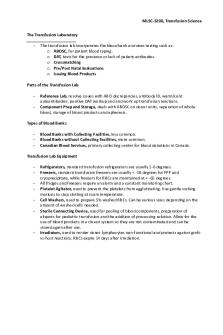
Intro to Transfusion Science
- 3 Pages

Unit 1 Intro to Bio
- 2 Pages

HW4 -5206 intro to data science
- 3 Pages

Lab Report Intro to Graphing
- 8 Pages
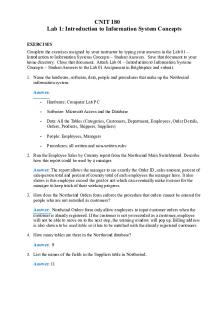
Lab 01- intro to system
- 2 Pages

Lab 1 - Intro to Measurement
- 10 Pages

Bio intro - stefan milenkovic
- 1 Pages
Popular Institutions
- Tinajero National High School - Annex
- Politeknik Caltex Riau
- Yokohama City University
- SGT University
- University of Al-Qadisiyah
- Divine Word College of Vigan
- Techniek College Rotterdam
- Universidade de Santiago
- Universiti Teknologi MARA Cawangan Johor Kampus Pasir Gudang
- Poltekkes Kemenkes Yogyakarta
- Baguio City National High School
- Colegio san marcos
- preparatoria uno
- Centro de Bachillerato Tecnológico Industrial y de Servicios No. 107
- Dalian Maritime University
- Quang Trung Secondary School
- Colegio Tecnológico en Informática
- Corporación Regional de Educación Superior
- Grupo CEDVA
- Dar Al Uloom University
- Centro de Estudios Preuniversitarios de la Universidad Nacional de Ingeniería
- 上智大学
- Aakash International School, Nuna Majara
- San Felipe Neri Catholic School
- Kang Chiao International School - New Taipei City
- Misamis Occidental National High School
- Institución Educativa Escuela Normal Juan Ladrilleros
- Kolehiyo ng Pantukan
- Batanes State College
- Instituto Continental
- Sekolah Menengah Kejuruan Kesehatan Kaltara (Tarakan)
- Colegio de La Inmaculada Concepcion - Cebu

